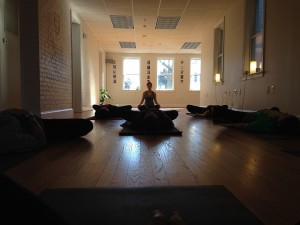I’m always amazed by how much yoga teachers talk during their yoga classes. Sometimes it feels like I’m attending a lecture on life, the universe, and everything. Not a class where the goal is to quiet down the mind (or the “mind-stuff” as it’s called in the Yoga Sutras).
As you sweat your way through several rounds of sun salutations or downward-facing dog, your yoga teacher may fill every quiet moment with a dizzying array of facts — from what she had for breakfast that morning to how much traffic was on the road while she was biking to the studio in her handmade leggings and recycled bicycle helmet cover.
This endless chit-chat happens not only during active yoga classes, but also in meditation classes, like one that I watched recently on YogaGlo.
During that 10-minute meditation, the yoga teacher talked the entire way through, pausing only to breathe and to lull me into a false sense of meditation. Every time I thought I had finally focused on the mantra he had given us, he would talk again.
Often it was just to remind me how to get into the meditative state that he had just startled me out of.
Shut Up and Let Yoga Happen
 As a yoga teacher, I have always been conscious of how much I talk during class. But once I stopped playing music during my classes, I became even more aware of how easily my voice can break the silence — like popping a soap bubble floating through the air.
As a yoga teacher, I have always been conscious of how much I talk during class. But once I stopped playing music during my classes, I became even more aware of how easily my voice can break the silence — like popping a soap bubble floating through the air.
But it’s not just other yoga teachers that I want to scream at. Sometimes when I’m teaching, I have the urge to tell myself to shut up.
So I always try to keep my talking to a minimum. When funny stories about my morning commute or kale smoothie pop into my head, I take a breath and let them go. For me, teaching is a kind of meditation.
This allows me to keep my focus where it should be … on my students. It also gives my students a little more space to focus on their own yoga practice.
Of course, this is easier said than done.
Why Do Yoga Teachers Talk So Much?
Maybe yoga teachers talk so much during class because they are naturally social. But my guess is that many of us talk to fill the awkward silences that pop up in between our verbal cues.
There’s also a great deal of pressure in teaching a yoga class. Here you are, standing in front of a group of 10 (or 40) people who have all paid for you to give them a certain kind of “experience.” That’s a lot of pressure.
And no one else is allowed to talk.
All of this allows the thoughts bubbling up in the speech centers of your brain to spill out uncontrolled from your mouth.
New yoga teachers are especially prone to excessive talking. Talking is like an ice-breaker in the middle of yoga class. Of course, when I was a new teacher, I talked so much that I could have saved the Titanic from running into the iceberg.
Is All That Yoga Talk Necessary?
 Of course, some of what yoga teachers say in class is directly related to what the students are doing. This includes:
Of course, some of what yoga teachers say in class is directly related to what the students are doing. This includes:
- tips for getting into and out of the pose safely
- reminders to breathe smoothly throughout the class
- motivation to help you stay in a challenging pose for just a little bit longer
But teachers should probably avoid too much witty banter during class. This includes telling personal smoothie stories or tales about yoga “back in the day.”
As for yoga philosophy, it can be tricky to decide how much to include during class. In general I think most yoga students (myself included) could stand to learn a little bit more about the foundations of yoga.
But is the middle of an asana practice the best place to share this information with yoga students?
Multitasking During Yoga Class
The problem with trying to teach philosophy and yoga poses at the same time is that students can’t focus on both. They will either be listening to what you are saying about Patañjali’s thoughts on commuting in New York City, or they will be paying attention to what they are doing in the yoga pose.
Not both at the same time.
No matter what we tell ourselves, most of us (around 98 percent!) are not very good at multitasking. When you think you are doing two things at the same time, you are really just flipping quickly between them.
And each time you add a new task to what you are doing, you pay less attention to the original activity.
So when a yoga teacher starts to talk about the exploits of Hanuman or Krishna while you are trying to focus on getting into crow pose, your brain automatically siphons off part of its awareness to pay attention to what the teacher is saying.
That leaves you less focused on crow pose, and more likely to fall on your face and give yourself a nosebleed.
Finding the Right Amount of Talking
 Yoga teachers need to decide for themselves how much to talk during a yoga class.
Yoga teachers need to decide for themselves how much to talk during a yoga class.
I like to imagine that I have a finite number of words to use in a yoga class (and in life). If I talk too much, I will run out of words before the end (or before I die).
I try to say only what is absolutely necessary. I give verbal cues to help my students get into a pose. But if they don’t need any adjustments, I might hold back on the cues that I use in beginner classes to deepen the pose.
I also try to keep my pre-yoga class comments to a minimum. If someone wants to hear about the kale-quinoa salad I had for lunch, I’m sure they will ask me after class about my diet.
But it’s not just about muzzling the voices of yoga teachers. Sometimes silence can be a very effective teaching tool.
As for yoga philosophy, I use it sparingly.
If I have a focus for class — such as mindfulness or being kind to yourself — I will mention it at the beginning. This sets up the students to focus on this during the class … on their own, without continual reminders from me.
As for more in-depth discussions of philosophy, I think that this is best done by itself. Not while doing yoga poses.
Again, it’s a matter of focus. If I’m doing a yoga pose, I’m not focused entirely on the yoga philosophy. Plus, yoga philosophy should be a discussion between students and teacher, not just a teacher talking at a group of people who have paid their drop-in fee.
So yoga teachers, next time you go to teach a yoga class, remember this little bit of modern yoga philosophy:




What happened to “Shut the F*ck up! And let the yoga happen”? 😉
I’m saving that slogan for “special orders” only. 🙂
❤️💕🥰🫶
Just shut up and do yoga? I agree sometimes people( me included) just want to do yoga. But at the same time you can give a little bit more deeper into the history of Yoga. There is a lot to be said to actually make a connection with your students and let them know that you not perfect and that everything is a work in art. A lot of people think that space asanas are what get you get the most out of your practice. But talking about real world problems is another side of yoga.
Charles, you have some great points. It’s very important for students and teachers to connect. I also agree that talking about how yoga is relevant to our lives off the mat is a big part of yoga. I just question whether the best time to do this is while I’m trying to talk the students through Sun Salutations or downward-facing dog.
I like the way the Shambhala meditation centers handle this. Before a meditation session, students can meet with a teacher to talk about what they should be doing while on the meditation cushion. Then there is meditation, with no talking. Even when you switch to walking meditation, it is done by following the teacher’s example, without talking.
But after the meditation is over, there is often a dharma talk, where you talk about one aspect of Buddhism and how it relates to your own life. Doing it this way allows you to focus on meditating without distractions (well, other than the ones we always have in our minds). The focused meditation also calms your mind and prepares you for a deeper discussion of philosophy.
Thank you Shawn. It feels like a breath of fresh air to read your article. I’m so frustrated and unhappy that I can’t seem to find a teacher who doesn’t stop talking. The only one I found, whom I loved, was in London, but I no longer live there.
I loved this hot yoga studio down the road from me; at least I loved the owners on a personal level, but they could not stop talking during class on how to love yourselves to giving personal commercials, along with their opinions on what type of water bottles were best for the environment. By the time the class was over I was so stressed! Too bad, because I love hot yoga. I finally quit the class today, which took me a long time to do because I did genuinely like the owners.
Now, I think I’ve resorted to doing yoga at home. It’s the only place I can seem to find peace and quiet.
Siobhan,
Thanks for your comment. As a teacher, I know how easy it is to start babbling on without realizing it. I think part of the problem is that even teachers are uncomfortable with silence. I still catch myself talking about unrelated things, or things that I think will “enhance” the students’ experience, but are really just noise.
And congrats on your home yoga practice. I think everyone should work toward having a personal practice. You can always do the occasional class or find a qualified teacher to work with one-on-one. This will help your home practice from becoming stale.
Enjoy the peace and quiet.
Oh I wish I could attend your classes. Thanks for working on your own consciousness around noise. I’m sure it makes a huge difference.
Ha, my thoughts exactly. Just shut up and let me focus! My first mindfulness course was good, and I am grateful to my teacher, but she seemed terrified of silence, and would keep talking through all the meditations. I think we silence lovers are in a minority though. I discussed this with everyone in the class, including the teacher, and they all loved the chat.
But this the best bit. My mindfulness teacher recently returned from a week-long retreat and was really disappointed that the instructor didn’t talk enough, and remained silent through the meditations. No chatting, no New Age music, just silence. She said she thought about me and how I would have loved it.
Lewis,
Thanks for your note. That’s a great story. The silent week-long meditation is my kind of retreat. I also like the way the Shambhala Centers handle meditation. People have a chance to speak with a teacher before the meditation about what to expect and their experience last time. Otherwise it is silent. Sometimes they also have a dharma talk and discussion after the meditation.
I like it when a teacher talks, specifically Dharma Talks.
But yes, I wouldn’t want to hear teachers talking about their breakfast and commute experiences
Yoga is not only a physical exercise as you all know.
So do talk, but share dharma talks
“When you can comfortably share silence, that’s when you know you’ve found somebody [a yoga instructor] really special.” – Mia, Pulp Fiction.
I agree that silence can be a great an effective teaching tool. It gives students the space to be present as well as to reflect. (I was never a fan of music or talking, esp during the final resting post.) Moreover, silence encourages people to be alone with their thoughts (which granted, some might find scary but hey, that is telling of itself. Might be time to work on the Self mayhaps?)
Just stumbled onto your site: loving the resources so far. Thanks for sharing!
Krys,
That’s a great quote. I had forgotten about that one. I agree that being uncomfortable with silence may mean you have some personal stuff to work on. One reason I love meditation is that it forces me to come face-to-face (mind-to-mind?) with my inner self, mental warts and all.
Shawn
I left the yoga class today after 45 minutes. The yoga was fine–nice sequencing. But between the teacher’s chatter and the music/lyrics, I thought, “I can do this at home,” and have some peace. Thank you for your article. I’ve been teaching for decades and keep trying to find the least instruction for the most experience and safety. It’s not an easy balance but one to keep striving for.
I sleep better and feel more energized since starting yoga classes.
This is such an interesting perspective! Sometimes, the most powerful part of yoga is the silence—the space where students can truly connect with their breath and movement. While guidance is valuable, allowing room for personal experience and self-discovery is just as important. A great reminder that yoga is as much about feeling as it is about instruction. Thanks for sharing this thought-provoking insight!